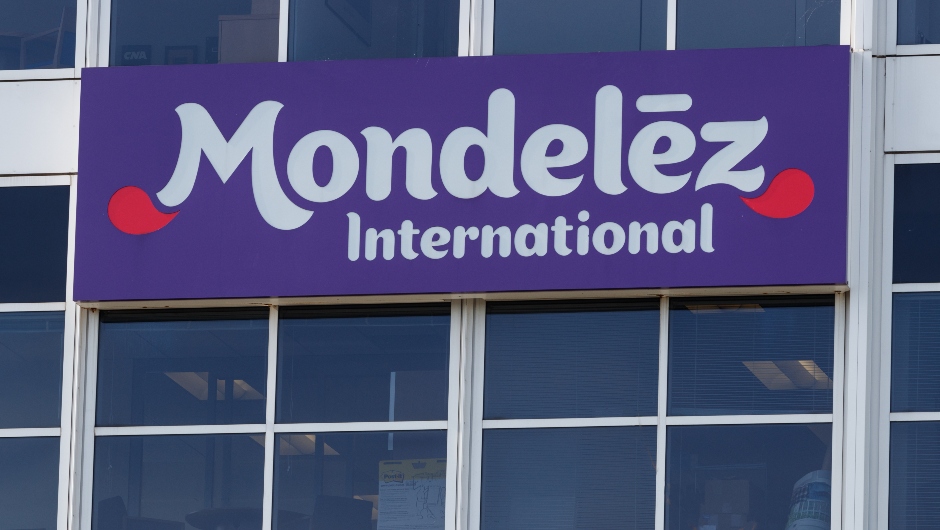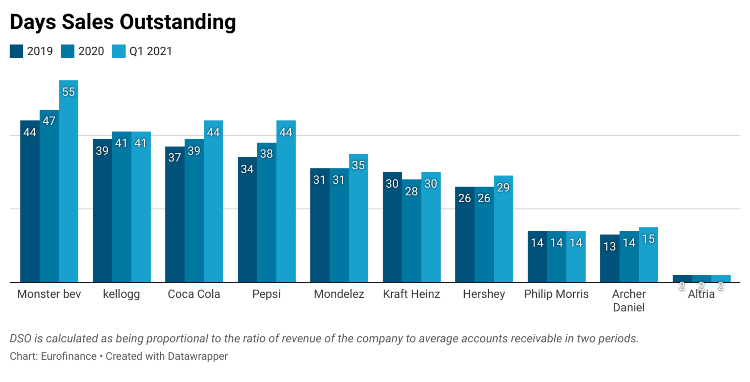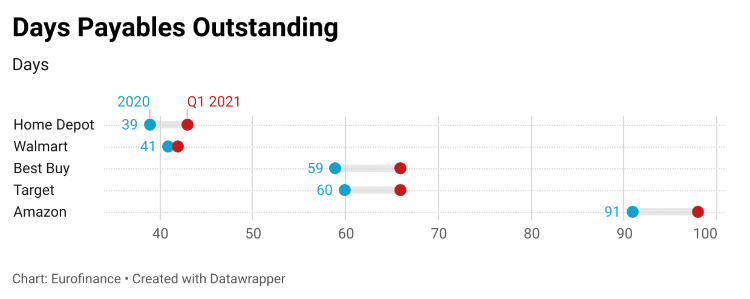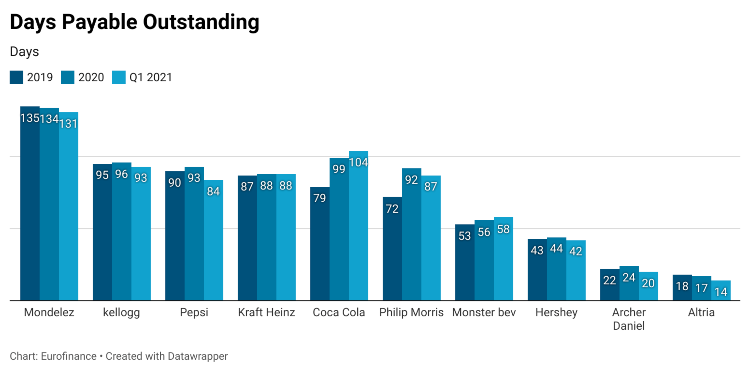Consumer goods giants sell receivables to support customers

Coca Cola, Mondelez and Archer Daniel financed an additional $1.3 billion of receivables via receivable factoring programs as DSO reaches a 7-year high in Q1 2021.
In the first quarter of 2021, US consumer goods companies recorded a 10.7% rise in the average Days Sales Outstanding (DSO), a measure of the average number of days that it takes for a company to collect payment after a sale has been made, to 31 days from 27.9 days in the previous quarter. The upsurge in DSO was driven by the favourable payment terms provided to the customer including distributors and retailers as they took five additional days on average to pay to the consumer companies during the same time period.
On top of receiving late payments, the companies faced extensive working capital pressure as they paid their suppliers faster than the previous quarter with Days Payables Outstanding (DPO) falling by 3% to 72 days. In order to alleviate the working capital constraints, trade receivables factoring facilities were utilized as Coca Cola, Mondelez and Archer Daniel financed an additional $1.3 billion of receivables during the first quarter.
Receivables-Payments mismatch
Major contributors to the rise in DSO were Coca Cola, Pepsi, Mondelez and Monster Bev as the metric surged by more than 10% during the quarter, resulting in an additional 6 days to collect payments after sale. This came at a time when the companies recorded strong consumer demand and supply chain normalization as governments eased social restrictions put in place to control the spread of Covid-19 a year ago.

These companies saw a similar rise in DSO during the early phase of the pandemic, as the traditional distribution networks were disrupted and the retailers asked suppliers for more time to pay their bills. This extension continued into the first quarter of 2021 as, the big box retailers including Amazon, Walmart, Target, BestBuy and Home Depot recorded an 8.5% surge in DPO to an average of 63 days.

On the contrary, the consumer goods companies didn’t have the luxury of relaxed payment terms with their suppliers as their DPO tumbled to an average of 72 days in the first quarter, signalling that payments were made 2 days quicker than the previous quarter. Commodity inflation also had its part to play in putting pressure on DPO as the cost of acquiring or manufacturing the products that the companies sold during a period rose dramatically.
DPO is inversely proportional to the cost of goods sold; hence any rise will reduce the metric.

Trade receivables factoring
The increased working capital stress due to a rise in DSO was worsened by the fall in DPO which resulted in companies including Coca Cola, Mondelez, Philip Morris, Archer Daniel and Kellogg finance $7.2 billion of trade receivables via receivables factoring programs with financial institutions. This represents a rise of 15% from the previous quarter.

As a part of this program, the company sells it trade account receivables to a third-party financial institution at a discount to receive cash before the customer pays the dues.
“We are implementing accounts receivables factoring programs, which are rolling out across a number of markets, and also looking at initiatives to better manage inventory days” said John Murphy, CFO at Coca Cola during an April 19th investor call.
The beverage manufacturer recorded a 14% rise in DSO to 44 days and a 26.8% rise in networking capital in Q1 2020, started a trade accounts receivable factoring program in certain countries in Q4 2020 with only $185 million of receivables sold during the quarter. This number escalated to $1.3 billion in the subsequent quarter.
While on the other hand of the spectrum, the multinational food processing company, Archer Daniels Midlands also saw its DSO and DIO rally by 6.5% and 19% during Q1 while DPO fell 15%, putting excessive pressure on its net working capital as it almost doubled to $12 billion to its pre-pandemic levels.
“I think the first priority is to continue to fund the working capital needs. It’s not a surprise. Commodity prices continue to go up right now. And so therefore, we will use our balance sheet to kind of fund additional working capital requirements.” said Ray Young, CFO at Archer Daniels Midland. The company also increased its receivables financing by $100 million to $1.7 billion during the quarter.
While on the contrary, another user of the receivable factoring program, Philip Morris International reduced its reliance on the product as it financed $2.5 billion of receivables in Q1, $400 million less than the previous quarter. The company was comfortable from a working capital perspective against its peers, as its CCC was down by 1.5% to 273 days while DSO stood firm at 14 days for the last two quarters.